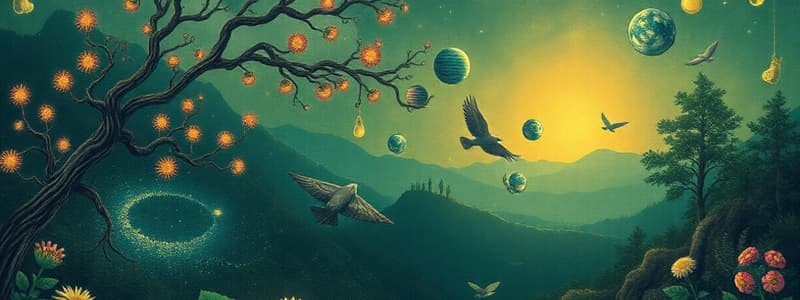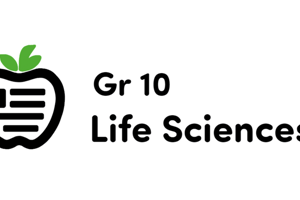Podcast
Questions and Answers
What role do chlorophyll-bearing organisms play in the carbon-oxygen cycle?
What role do chlorophyll-bearing organisms play in the carbon-oxygen cycle?
- They release carbon dioxide during respiration.
- They consume oxygen for energy.
- They break down organic compounds into nutrients.
- They take in carbon dioxide and release oxygen through photosynthesis. (correct)
How do terrestrial organisms primarily obtain oxygen?
How do terrestrial organisms primarily obtain oxygen?
- From mineral deposits in soil.
- From dissolved oxygen in water.
- From carbon dioxide in the atmosphere.
- Directly from the atmosphere. (correct)
What is one of the main effects of excessive carbon in the atmosphere?
What is one of the main effects of excessive carbon in the atmosphere?
- Aquatic life depletion.
- Global warming. (correct)
- Soil erosion.
- Increased photosynthesis rates.
Which process begins with organisms taking in oxygen from their surroundings?
Which process begins with organisms taking in oxygen from their surroundings?
Why are the carbon and oxygen cycles important for ecosystems?
Why are the carbon and oxygen cycles important for ecosystems?
During which process is glucose broken down to release energy?
During which process is glucose broken down to release energy?
Which of the following is a by-product of photosynthesis?
Which of the following is a by-product of photosynthesis?
What is the primary source of energy used by organisms during respiration?
What is the primary source of energy used by organisms during respiration?
What are the two basic types of biogeochemical cycles?
What are the two basic types of biogeochemical cycles?
Which of the following is classified as a macronutrient?
Which of the following is classified as a macronutrient?
What is the primary source of nutrients in the gaseous nutrient cycle?
What is the primary source of nutrients in the gaseous nutrient cycle?
Which macronutrient is not included in the list provided?
Which macronutrient is not included in the list provided?
Which two cycles are directly coupled to each other?
Which two cycles are directly coupled to each other?
Which of the following elements is a primary source of the sedimentary nutrient cycle?
Which of the following elements is a primary source of the sedimentary nutrient cycle?
How much oxygen is estimated to be released by photosynthesis each year?
How much oxygen is estimated to be released by photosynthesis each year?
What is the main role of biogeochemical cycles in ecosystems?
What is the main role of biogeochemical cycles in ecosystems?
What is the primary process by which precipitation contributes to freshwater sources?
What is the primary process by which precipitation contributes to freshwater sources?
What is runoff primarily associated with?
What is runoff primarily associated with?
Which process follows infiltration in the water cycle?
Which process follows infiltration in the water cycle?
Which of the following statements about subsurface outflow is true?
Which of the following statements about subsurface outflow is true?
What distinguishes the phosphorus cycle from other biogeochemical cycles?
What distinguishes the phosphorus cycle from other biogeochemical cycles?
Phosphate rocks serve what key role in the phosphorus cycle?
Phosphate rocks serve what key role in the phosphorus cycle?
How does precipitation impact ecosystems?
How does precipitation impact ecosystems?
What is the main role of the water cycle?
What is the main role of the water cycle?
What role do plants play in the carbon-oxygen cycle?
What role do plants play in the carbon-oxygen cycle?
What is the primary byproduct emitted during combustion?
What is the primary byproduct emitted during combustion?
How does deforestation affect the carbon-oxygen cycle?
How does deforestation affect the carbon-oxygen cycle?
Which process involves the breakdown of dead organisms by decomposers?
Which process involves the breakdown of dead organisms by decomposers?
What is carbon sequestration?
What is carbon sequestration?
Which of the following is a significant impact of burning fossil fuels?
Which of the following is a significant impact of burning fossil fuels?
What is the end result of decomposition in the carbon-oxygen cycle?
What is the end result of decomposition in the carbon-oxygen cycle?
In which form can water produced from combustion exist?
In which form can water produced from combustion exist?
What is the primary reason nitrogen gas is not accessible to plants and animals?
What is the primary reason nitrogen gas is not accessible to plants and animals?
Which process converts nitrogen gas from the atmosphere into a usable form for plants?
Which process converts nitrogen gas from the atmosphere into a usable form for plants?
What is the first step of nitrification known as?
What is the first step of nitrification known as?
How do plants incorporate nitrogen into their systems?
How do plants incorporate nitrogen into their systems?
What is ammonia converted into during the second step of nitrification?
What is ammonia converted into during the second step of nitrification?
Which type of organisms primarily carry out nitrification?
Which type of organisms primarily carry out nitrification?
What key compound is formed as a result of nitrogen fixation?
What key compound is formed as a result of nitrogen fixation?
Which of the following gases constitutes the largest percentage of the Earth's atmosphere?
Which of the following gases constitutes the largest percentage of the Earth's atmosphere?
What process breaks down rocks and releases phosphorus into the soil and water?
What process breaks down rocks and releases phosphorus into the soil and water?
How do plants incorporate phosphorus into their biological systems?
How do plants incorporate phosphorus into their biological systems?
What happens to organic phosphorus when a plant or animal dies?
What happens to organic phosphorus when a plant or animal dies?
Which term refers to the release of phosphorus from organic sources during decomposition?
Which term refers to the release of phosphorus from organic sources during decomposition?
What effect do fertilizers have on the phosphorus cycle?
What effect do fertilizers have on the phosphorus cycle?
Why is phosphorus considered a limiting nutrient in many ecosystems?
Why is phosphorus considered a limiting nutrient in many ecosystems?
Which of the following plays a role in the phosphorus cycle by transferring phosphates to water systems?
Which of the following plays a role in the phosphorus cycle by transferring phosphates to water systems?
What aspect of human activity has disrupted the natural balance of phosphorus cycles?
What aspect of human activity has disrupted the natural balance of phosphorus cycles?
Flashcards
Biogeochemical Cycles
Biogeochemical Cycles
The movement of chemical substances through the biosphere, geosphere, hydrosphere, and atmosphere, ensuring essential elements are continuously exchanged.
Macronutrients
Macronutrients
Essential nutrients required in large amounts by organisms, including Carbon, Hydrogen, Oxygen, Nitrogen, Potassium, Calcium, Magnesium, Sulfur, and Phosphorus.
Micronutrients
Micronutrients
Essential nutrients required in small amounts by organisms, including Iron, Manganese, Copper, Zinc, Boron, Sodium, and others.
Gaseous Nutrient Cycle
Gaseous Nutrient Cycle
Signup and view all the flashcards
Sedimentary Nutrient Cycle
Sedimentary Nutrient Cycle
Signup and view all the flashcards
Carbon Cycle
Carbon Cycle
Signup and view all the flashcards
Photosynthesis
Photosynthesis
Signup and view all the flashcards
Respiration
Respiration
Signup and view all the flashcards
Carbon-Oxygen Cycle
Carbon-Oxygen Cycle
Signup and view all the flashcards
Why is the Carbon-Oxygen Cycle important?
Why is the Carbon-Oxygen Cycle important?
Signup and view all the flashcards
What happens when there's excessive carbon?
What happens when there's excessive carbon?
Signup and view all the flashcards
How does respiration impact the oxygen cycle?
How does respiration impact the oxygen cycle?
Signup and view all the flashcards
What happens to CO2 during respiration?
What happens to CO2 during respiration?
Signup and view all the flashcards
How does the carbon cycle balance CO2?
How does the carbon cycle balance CO2?
Signup and view all the flashcards
Oxygen Replenishment
Oxygen Replenishment
Signup and view all the flashcards
Decomposition
Decomposition
Signup and view all the flashcards
Fossil Fuel Formation
Fossil Fuel Formation
Signup and view all the flashcards
Combustion
Combustion
Signup and view all the flashcards
Human Impact on Combustion
Human Impact on Combustion
Signup and view all the flashcards
Carbon Sequestration
Carbon Sequestration
Signup and view all the flashcards
How Plants Sequester Carbon
How Plants Sequester Carbon
Signup and view all the flashcards
Importance of Carbon Sequestration
Importance of Carbon Sequestration
Signup and view all the flashcards
Precipitation
Precipitation
Signup and view all the flashcards
Runoff
Runoff
Signup and view all the flashcards
Subsurface Outflow
Subsurface Outflow
Signup and view all the flashcards
Infiltration
Infiltration
Signup and view all the flashcards
Phosphorus Cycle
Phosphorus Cycle
Signup and view all the flashcards
Phosphate Rocks
Phosphate Rocks
Signup and view all the flashcards
Why is phosphorus important?
Why is phosphorus important?
Signup and view all the flashcards
How does phosphorus move?
How does phosphorus move?
Signup and view all the flashcards
Nitrogen Fixation
Nitrogen Fixation
Signup and view all the flashcards
Why is nitrogen fixation important?
Why is nitrogen fixation important?
Signup and view all the flashcards
Nitrification
Nitrification
Signup and view all the flashcards
Steps of Nitrification
Steps of Nitrification
Signup and view all the flashcards
Assimilation
Assimilation
Signup and view all the flashcards
How do plants and animals get nitrogen?
How do plants and animals get nitrogen?
Signup and view all the flashcards
What is weathering in the phosphorus cycle?
What is weathering in the phosphorus cycle?
Signup and view all the flashcards
How do plants get phosphorus?
How do plants get phosphorus?
Signup and view all the flashcards
How do animals get phosphorus?
How do animals get phosphorus?
Signup and view all the flashcards
What is sedimentation in the phosphorus cycle?
What is sedimentation in the phosphorus cycle?
Signup and view all the flashcards
What is fertilizer runoff?
What is fertilizer runoff?
Signup and view all the flashcards
Why is the phosphorus cycle important?
Why is the phosphorus cycle important?
Signup and view all the flashcards
What is the nitrogen cycle?
What is the nitrogen cycle?
Signup and view all the flashcards
Why is the nitrogen cycle important?
Why is the nitrogen cycle important?
Signup and view all the flashcards
Study Notes
Biogeochemical Cycles
- Biogeochemical cycles are also known as nutrient cycles
- They describe the movement of chemicals between the biosphere, geosphere, hydrosphere, and atmosphere
- Cycles ensure that essential elements are continually exchanged between organisms and the environment, maintaining balance in ecosystems
- Macronutrients are required in relatively large amounts (e.g., carbon, hydrogen, oxygen, nitrogen, potassium, calcium, magnesium, sulfur, and phosphorus)
- Micronutrients are required in small quantities (e.g., iron, manganese, copper, zinc, boron, sodium)
Types of Biogeochemical Cycles
- Gaseous Nutrient Cycles: The main sources of nutrients are the atmosphere and oceans.
- Important gases for life are nitrogen, oxygen, and carbon dioxide.
- These gases occur in stable proportions (e.g., nitrogen – 78%, oxygen – 21%, carbon dioxide – 0.03%)
- Examples include the nitrogen cycle, oxygen cycle, and carbon cycle
- Sedimentary Nutrient Cycles: The main sources are soil, rocks, and minerals.
- Mineral elements initially come from inorganic sources
- Mineral salts come directly from the Earth's crust through weathering
- Examples include the sulfur cycle and the phosphorus cycle
Carbon-Oxygen Cycle
- The carbon cycle is fully coupled with the oxygen cycle
- Photosynthesis fixes carbon dioxide and releases oxygen to the atmosphere (100,000 megatons per year)
- Respiration by animals and living organisms consumes oxygen and produces carbon dioxide
- These are two linked cycles
Carbon-Oxygen Cycles: Processes
- Photosynthesis: Green plants and other organisms transform light energy into chemical energy, converting water, carbon dioxide and minerals into oxygen and energy-rich organic compounds
- Respiration: Organisms take in oxygen and break down glucose to produce energy, releasing carbon dioxide
- Decomposition: Decomposers like bacteria and fungi break down dead organisms, releasing carbon into the soil and atmosphere. This carbon can be incorporated in fossil fuels over millions of years
- Combustion: Burning of organic materials releases carbon dioxide and water
- Human Impact: Burning of fossil fuels and deforestation release excessive carbon dioxide into the atmosphere, impacting climate change patterns
Water Cycle: Processes
- Evaporation: Solar energy heats water bodies and turns liquid water to water vapor, which rises into the atmosphere
- Transpiration: Plants absorb water through their roots and release water vapor into the atmosphere
- Condensation: Warm water vapor rises into the atmosphere and cools down, condensing to liquid water or ice forming clouds
- Precipitation: Water droplets in clouds get large enough to overcome air resistance and fall back to the Earth as rain, snow, sleet, or hail
- Runoff: Precipitation that doesn't infiltrate the ground flows over the Earth's surface, collecting in rivers, lakes, and eventually reaching the ocean
- Infiltration: Precipitation can also enter the soil and move downward, becoming groundwater
- Subsurface Outflow: Groundwater flows back to rivers, lakes, or oceans
Phosphorus Cycle: Processes
- Phosphate Rock Formation: Phosphorus is stored in phosphate rock formations and is a primary source for fertilizer production. This is a nonrenewable resource
- Weathering: Rain and erosion break down rocks, releasing phosphorus into the soil and water
- Plants: Plants absorb inorganic phosphate from the soil and incorporate it into organic molecules like DNA
Nitrogen Cycle: Processes
- Nitrogen Fixation: Bacteria convert atmospheric nitrogen gas into ammonia
- Ammonification: Decomposers break down organic nitrogen compounds to form ammonia
- Nitrification: Bacteria convert ammonia to nitrite and then to nitrate; this is crucial for plant uptake
- Assimilation: Plants absorb nitrate for protein and nucleic acid synthesis
- Denitrification: Bacteria convert nitrate back into atmospheric nitrogen gas
Sulfur Cycle: Processes
- Weathering of Rocks: Releases sulfur into the soil
- Volcanic Activity: Releases sulfur dioxide into the atmosphere
- Sulfur Assimilation: Plants absorb sulfur in the form of sulfate
- Decomposition: Bacteria decompose dead organisms, returning sulfur to the soil
- Acid Rain: Sulfur dioxide combines with water vapor forming sulfuric acid leading to acid rain
- Oceanic Sulfur: Marine organisms incorporate sulfate in biological processes, dimethyl sulfide (DMS) contributes to cloud formation, sulfates in ocean sediments return to the lithosphere over time
Studying That Suits You
Use AI to generate personalized quizzes and flashcards to suit your learning preferences.




